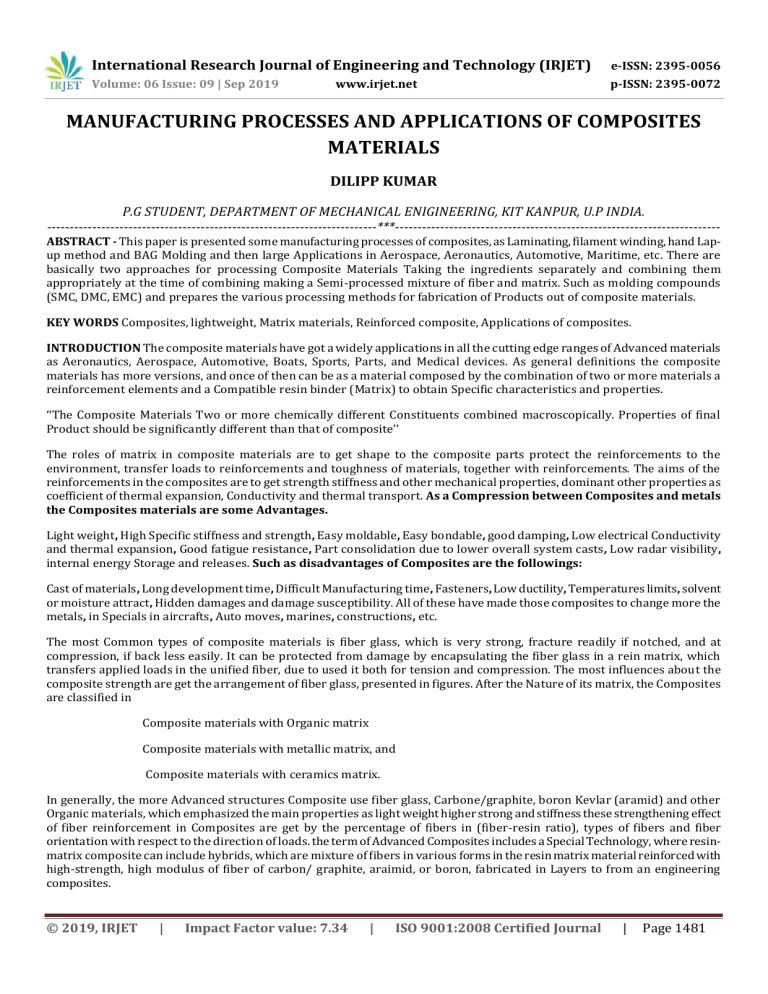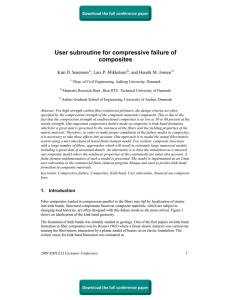IRJET-Manufacturing Processes and Applications of Composites Materials
advertisement

International Research Journal of Engineering and Technology (IRJET) e-ISSN: 2395-0056 Volume: 06 Issue: 09 | Sep 2019 p-ISSN: 2395-0072 www.irjet.net MANUFACTURING PROCESSES AND APPLICATIONS OF COMPOSITES MATERIALS DILIPP KUMAR P.G STUDENT, DEPARTMENT OF MECHANICAL ENIGINEERING, KIT KANPUR, U.P INDIA. -------------------------------------------------------------------------***------------------------------------------------------------------------ ABSTRACT - This paper is presented some manufacturing processes of composites, as Laminating, filament winding, hand Lapup method and BAG Molding and then large Applications in Aerospace, Aeronautics, Automotive, Maritime, etc. There are basically two approaches for processing Composite Materials Taking the ingredients separately and combining them appropriately at the time of combining making a Semi-processed mixture of fiber and matrix. Such as molding compounds (SMC, DMC, EMC) and prepares the various processing methods for fabrication of Products out of composite materials. KEY WORDS Composites, lightweight, Matrix materials, Reinforced composite, Applications of composites. INTRODUCTION The composite materials have got a widely applications in all the cutting edge ranges of Advanced materials as Aeronautics, Aerospace, Automotive, Boats, Sports, Parts, and Medical devices. As general definitions the composite materials has more versions, and once of then can be as a material composed by the combination of two or more materials a reinforcement elements and a Compatible resin binder (Matrix) to obtain Specific characteristics and properties. ‘‘The Composite Materials Two or more chemically different Constituents combined macroscopically. Properties of final Product should be significantly different than that of composite’’ The roles of matrix in composite materials are to get shape to the composite parts protect the reinforcements to the environment, transfer loads to reinforcements and toughness of materials, together with reinforcements. The aims of the reinforcements in the composites are to get strength stiffness and other mechanical properties, dominant other properties as coefficient of thermal expansion, Conductivity and thermal transport. As a Compression between Composites and metals the Composites materials are some Advantages. Light weight, High Specific stiffness and strength, Easy moldable, Easy bondable, good damping, Low electrical Conductivity and thermal expansion, Good fatigue resistance, Part consolidation due to lower overall system casts, Low radar visibility, internal energy Storage and releases. Such as disadvantages of Composites are the followings: Cast of materials, Long development time, Difficult Manufacturing time, Fasteners, Low ductility, Temperatures limits, solvent or moisture attract, Hidden damages and damage susceptibility. All of these have made those composites to change more the metals, in Specials in aircrafts, Auto moves, marines, constructions, etc. The most Common types of composite materials is fiber glass, which is very strong, fracture readily if notched, and at compression, if back less easily. It can be protected from damage by encapsulating the fiber glass in a rein matrix, which transfers applied loads in the unified fiber, due to used it both for tension and compression. The most influences about the composite strength are get the arrangement of fiber glass, presented in figures. After the Nature of its matrix, the Composites are classified in Composite materials with Organic matrix Composite materials with metallic matrix, and Composite materials with ceramics matrix. In generally, the more Advanced structures Composite use fiber glass, Carbone/graphite, boron Kevlar (aramid) and other Organic materials, which emphasized the main properties as light weight higher strong and stiffness these strengthening effect of fiber reinforcement in Composites are get by the percentage of fibers in (fiber-resin ratio), types of fibers and fiber orientation with respect to the direction of loads. the term of Advanced Composites includes a Special Technology, where resinmatrix composite can include hybrids, which are mixture of fibers in various forms in the resin matrix material reinforced with high-strength, high modulus of fiber of carbon/ graphite, araimid, or boron, fabricated in Layers to from an engineering composites. © 2019, IRJET | Impact Factor value: 7.34 | ISO 9001:2008 Certified Journal | Page 1481 International Research Journal of Engineering and Technology (IRJET) e-ISSN: 2395-0056 Volume: 06 Issue: 09 | Sep 2019 p-ISSN: 2395-0072 www.irjet.net An important distinguishing between composites from reinforced plastics is the fiber to resin ratio, usually this ratio is greater than 50% fiber per weight. It’s used for combination of epoxy-resin matrix materials reinforced with modulus fibers of carbon and fabrication in a multilayer from, assured a higher rigidity and strong structure. 2. MANUFACTURING PROCESSES OF COMPOSITE MATERIALS As an observation, can mention that in same Application of ADVANCED COMPOSITE MATERIALS the individual Layer may themselves be composites, usually fiber-matrix type composites fabrication have many processes some of the most important processes are Hand and automated tape lay-up Resin injection, Compression molding Pultrusion. Filament winding. SANDWICHES: Which are multiple layer Structure materials containing a low-velocity Core between thin faces (skins) of composite materials. Other Classification of Composites processes can be after the process volume, which due to of two Categories: has low volume. 2.1 LAMINATING PROCESSES The Laminating Process is Large used at fabrication of advanced fibers and matrix materials of Composites to improve the processes it can be used a prepared materials, which is a prelim prenatal reinforced material with high Composite’s Property by fibers aligned parallel to each other. A Sample of product’s from is cut off by variety proceeding and the prepare material is fixed into desired Laminate geometry. The final work piece is achieved by curing the stacked plies under pressure and heat in an autoclave. Fig.1 Laminating winding The Graphite –epoxy Composite is cured at aprox 180 and at pressure of 0.7MPa, and for high temperature composite such as 320 . The tooling is requested a mold following a part through the Lay-up and autoclaving process, as material tooling for fabrication of composites Lap-up aluminum steel electroplate nickel, a high- temperature epoxy resin system casting. 2.2 FILAMENT WINDING PROCESS A process for fabricating a composite structure in which Continuous, Reinforcements (filament, wire, yarn, tape or other) either previously impregnated with a matrix material or impregnated during © 2019, IRJET | Impact Factor value: 7.34 | ISO 9001:2008 Certified Journal | Page 1482 International Research Journal of Engineering and Technology (IRJET) e-ISSN: 2395-0056 Volume: 06 Issue: 09 | Sep 2019 p-ISSN: 2395-0072 www.irjet.net Fig. 2 Filament winding Fig.3 filament winding Se-up the winding are placed over a rotating and removable from a rotating and removable from the mandrel in a previously prescribed way to meet certain stress conditions generally the shape is a surface of revolution and may not include end are applied the wound and from is cured and the mandrel removed. 2. 3 HAND LAY-UP METHOD Resin applied over reinforcement materials (on a layer by layer basis) and Consolidated manually. Layer of gel-code for releasing cured product from the mould Fig.4 Hand lay-up method The process of placing (and working) Successive plies of reinforcing materials or resin-impregnated reinforcement in position on a mould by hand. 2.4 BAG MOLDING PROCESSES The BAG molding processes in this process- long Continuous fibers (mat, or real’s or tapes) Advanced Composites materials of fibers unidirectional long continuous and short fibers unidirectional composites materials. In this processes in applications of randomly oriented short fibers composite typical bag molding processes set-up’s. PRESSURE BAG MOLDING PROCESS A process for molding reinforced plastic, in which a Tail oared flexible bag is placed over the contact lay-up on the mould, sealed and clamped in place. © 2019, IRJET | Impact Factor value: 7.34 | ISO 9001:2008 Certified Journal | Page 1483 International Research Journal of Engineering and Technology (IRJET) e-ISSN: 2395-0056 Volume: 06 Issue: 09 | Sep 2019 p-ISSN: 2395-0072 www.irjet.net Fluid pressure usually compressed air in placed against the bag and the part cured. VACUUME BAG MOLDING: A process of molding reinforced plastic in which sheet of flexible transport materials is placed over the lay-up on the mould and sealed. A vacuum is place is applied between the sheet and mechanically worked out of the lay-up and removed by the vacuum, and the part is cured also bag molding. APPLICATION OF COMPOSITE MATERIALS: The market activity of advanced composite materials (ACMs) is concentrated mainly in three areas: Aerospace/ Aircraft recreational: and industrials. Automobiles and other miscellaneous applications constitute a relatively modest market. Major market activities of advanced composite materials for (ACMs) 1985 it appears that the demand for (ACMs) will grow by 15% annual during the next decade. At present the United States consumption represented about 60% of the total. Advanced ablative composite materials are used in re-entry vehicles for space explorations and also for fabrication of motor/ launch tubes for rockets’/missile/launch vehicles’, pressure gas storage vehicles, and nozzles in different rockets/space vehicles. Epoxy- graphite is most widely used for Structural applications (wings and tail sections pressure vessels and seat rails) in F18 and AU-8B Aircraft. This also finds extensive structural applications in Boeing 757and 767 ailerons, elevators, rudders, and Spoilers, etc. Graphite – Kevlar – epoxy hybrid advanced composite materials are extensively used for wing/ body fairings landing gear doors and trailing – edge panels. The aircraft’s advanced design and composite constructions provided high strength lighter weight and less drag the aircrafts undertaking trails are. Future military aircraft are likely to used 40% - 50% (ACMs) and therefore, will be lighter with improved performance and will be considerably more fuel – efficient. All – composite motor blades of Swiss supper puma helicopter are fabricate using hybrid glass/carbon/agamid prepress and possess unlimited life, immunity to corrosion and impact, fail-safe performance, deicing capability and maintenance casts. CONCLUSION This paper has presented certain fabrication technique for composite materials and some applications of advanced materials the selection of adequate technique is given by types of composite applications, quality parts size of production, casts, etc. The high property of composites and large applications of then led to chance the materials parts with composites in cutting edges ranges of economy. REFERENCE [1] POP. P Adrian1, BEJINARU MIHOC Gheorghe2 Manufacturing process and application of Composite materials. [2] Dr. PM Mohite AE-681 composite, office AE-11 Aerospace Engineering. [3] JP Aggrawal Scientist “Explosives Research and Development Laboratory Pune. [4] Defense Scientific Information DEVELOPMENT Center (DESIDOC). © 2019, IRJET | Impact Factor value: 7.34 | ISO 9001:2008 Certified Journal | Page 1484 International Research Journal of Engineering and Technology (IRJET) e-ISSN: 2395-0056 Volume: 06 Issue: 09 | Sep 2019 p-ISSN: 2395-0072 www.irjet.net [5] Defense Research and Development Organization ministry of Defense Delhi – 110054. [6] G. R. Arpitha, M. R. Sanjay, B. yogesha State-of Art on Hybridization of natural fibers reinforced Polymer Composites. BIOGRAPHY DILIP KUMAR: P.G STUDENT, DEPARTMENT OF MECHANICAL ENIGINEERING, KIT KANPUR, U.P INDIA. © 2019, IRJET | Impact Factor value: 7.34 | ISO 9001:2008 Certified Journal | Page 1485

